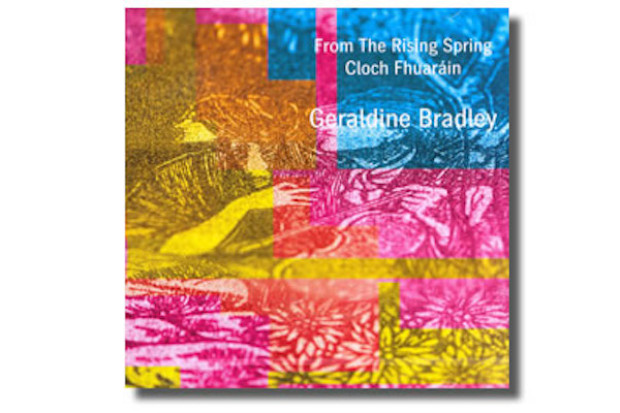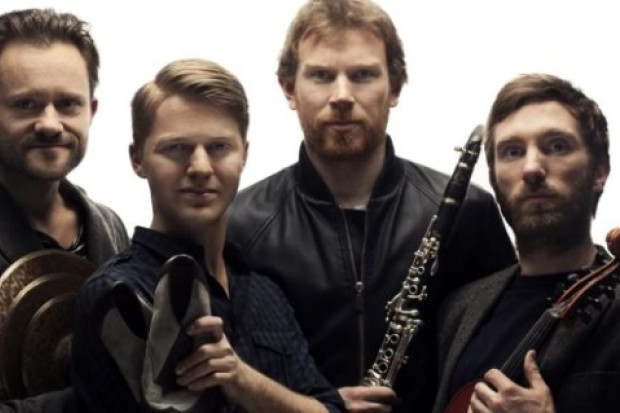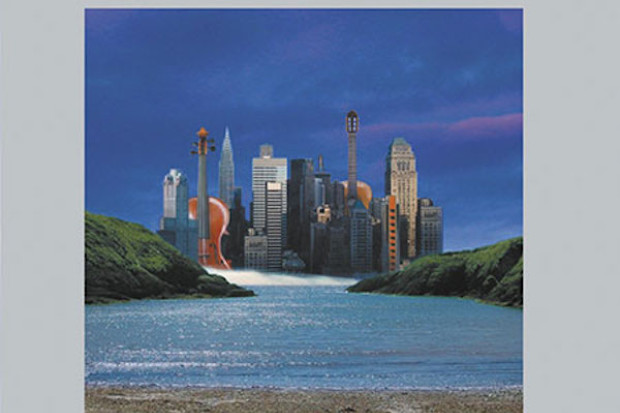New Music: Branding
Concert
Kronos Quartet, with special guest
Tony MacMahon (button-accordion)
O’Reilly Theatre, Dublin
September 16th 2004
CD
In Winter Light
John Buckley
Performed by John Feeley and William Dowdall
Celestial Harmonies 13244-2
Lost in translation
It is the curse of musicians that we live in a literal and visual culture.
While composers and performers create a culture in the medium of sound, and communicate these among themselves as sounds or notes on a page, presenting this work to the public requires a translation, into words and images.
Musicians frequently (ahem) can read and write, and are familiar as the next person with the visual media; so it might be supposed that they should be the ones to do the translating when the explaining and the marketing arises. But their main job, and their part-time jobs too, leave too little time for that. And anyway, advertising or marketing are skilled professions, not hobbies. So it often happens that the translation work is done by people who don’t ‘speak’ the original language. That’s odd.
But also, many composers and musicians carry on with no structured ‘brand’ or ‘image’, no translators. Something curious happens to them then. After a few years of toiling to produce something fresh, exciting, and maybe unique, they turn around to be confronted by what feels like a wall of prejudice, because the world, too busy to listen, slots them into the handiest ‘default’ category. The ‘default’ categories from the field of contemporary music include: ‘community’ composer, ‘academic’ (or worse, ‘campus’) composer, ‘digital’ composer (currently a sexy category, but for how long?), multimedia composer, media composer, pedagogical composer, jazz composer, crossover composer and so on.
You can be active in several of these areas, but your wider public will usually put you firmly into just one – or else go around saying, ‘I’m never sure about so-and-so’s music, I can’t get a handle on where he’s coming from’. This leaves the composer with the stark choice: either promote an image you are more or less comfortable with, or get saddled with one you are probably not. Of course there are, after all that, two kinds of composer, those who worry about all this and those who completely disregard it, perhaps claiming ‘art’ is not about any of this. But can you really divorce ‘culture’ from ‘the culture’?
Logo or no logo
The serious composer who has been around for enough time to become ‘established’, has not strained to cultivate a particular image, and has written mostly instrumental (i.e. little or no tape or computer) music now risks classification as an old fogey, an ‘academic’ composer – not a good thing. They suffer this fate if they have allowed their music to be performed in the standard institutions: concert halls rather than tents. In contrast, a younger generation of composers has now emerged that frequently projects an image of itself as ‘street’; positing a recalibration of ‘art-music’ values to accommodate a sprinkling of techno and art-rock influences. Sometimes their badly-concealed desire to replace the older generation rather than truly ignore them, shows that their idea of ‘underground’ is actually more akin to ‘waiting room’!
But what is really happening there is that the young composers are striking a pose without, maybe, having thought it all through. It may occur to them one day that the old fogeys used to be the wild young things too, and carried on doing the same stuff until fickle perceptions reclassified them as old hat.
A minority of established older composers escape these troublesome labels; why? Sometimes it is a question of having the knack of keeping relevant, stylistically. That is not to be underestimated – the ability to keep it fresh sounding, braveness to challenge ones own comfort-zones: as Donnacha Dennehy puts it, ‘to write the music you don’t like yet’. The bottom line, however, is that the surface of the music must be striking, which unfortunately often allows superficial music to fare better than multi-layered music. The problem of composers tailoring their style for rapid uptake/popularity raises itself, but that opens up a huge discussion which I will pass by for now. Sheer luck plays a part too: if the string quartet (old hat medium) you have written attracts the attention of the Kronos quartet, then suddenly it’s an electric string quartet. That’s better then.
The concert that Kronos gave on September 16th showed a truly remarkable range of content and style, in all senses of the words. That they could attract audiences from disparate worlds: jazz, rock, traditional, film music, and in addition a wide choice of art-music, without repelling any sector, shows they are not only the trail-blazers in tearing down barriers, but remain the market leaders as well. They cracked the marketing nut long ago and have long since attained the holy grail; brand loyalty.
Being honest, I expected the Kronos concert to include several items that would irritate me, and that together with the €45 ticket price would normally have been enough to stop me going. But I also hoped my prejudices would face a challenge. The programme had various genres each in its own section, so the first three items were arrangements of popular Mexican music from the 1930s-50s. These made an impression of melancholy sentimentality, with occasional bursts of cheerier but soupy melody. The third of the three had a further layer added, having been adapted and arranged for film, with an accompanying tape featuring among other things gongs and temple blocks, creating an effect of re-composing to give a sense of danger-music; rather cheap. The next two items were for me a segue into the contemporary music area, starting with the much more interesting piece Children’s Hour of Dream by Charlie Mingus. Although he shared, broadly, a similar tonal language to the first three items, here was not a trace of saccharine; instead a darkly intense dream-like logic carried the listener. With the next piece, Requiem for a Dream by Clint Mansell, we were returned to shoddy film music, with a boring underlay of accompanying material overlaid by a dull melody. After a while one last-ditch transfusion of excitement came, in the form of a massive textural lurch into scratchy quasi-industrial timbre.
The effect was to make you more curious about the film than its music.
The next section comprised the only two pieces not arranged for Kronos, but actually written for them as concert pieces. This difference was immense, as it turned out. Kevin Volans’ eighth quartet, Black Woman Rising, was soaked in the language of earlier Volans pieces; that impression was dominant throughout, and in fact the composer says that it quotes a number of pieces written in the late 90s. But the piece made a very cogent whole that I would look forward to hearing again. Here was a composer who has acquired a strong presence through his proximity to ‘brands’ such as Kronos coupled with his force of musical personality. The next piece, Potassium, by Michael Gordon, a composer synonymous with the tougher Bang On a Can brand, took advantage of the presence of amplification in a way that the Volans did not. This was the only piece in the programme to exploit amplification as an artistic element, and as such it stood out. Taking its time to unfold, nevertheless the piece was gripping, as simple rock-guitar effects such as fuzz and heavy reverb were applied intelligently and humorously to the string quartet, allowing them to return to material with this added layer completely changing its context.
The final section of programme was four traditional tunes from Tony MacMahon with the quartet accompanying. Most of the time the accompaniment seemed a somewhat harmless and completely unnecessary embellishment, though somewhere folk were spinning at 78rpm in the grave. At other times the quartet’s material intruded quite tastelessly; for example, high glissandi perverting the beautiful air ‘Port na bPúcaí’. The juxtaposition of Kronos with Tony MacMahon, though sincerely motivated, might as well have been a crude marketing ploy to show that Kronos’ openness and adaptability has no limits; unfortunately it does.
The second encore was prefaced with anti-Bush remarks, and the introduction ‘this tune was made famous by Jimi Hendrix in 1969’: it turned out to be a brilliant polyphonic feedback-bedecked perversion of ‘The Star-Spangled Banner’.
In Winter Light
In a CD recorded and produced by guitarist John Feeley, he and flautist William Dowdall collect together, as if in a reference book, John Buckley’s guitar and flute music. All the pieces except the last one are for the solo instruments. In Winter Light is the last piece on the CD and is for alto flute and guitar. John Buckley is not a composer who brings any strong sense of ‘breaking with the past’ to his music, he is perhaps a ‘no logo’ composer. In these pieces, which include his two substantial guitar sonatas, there is always a strong sense of linear evolution. The listener is led gently enough along: Buckley allows many comforting gestures such as accelerando coupling crescendo or ritardando coupling decrescendo. These can turn the thrill-seeking avant-gardist off, but in fact there is a strength of structure and beauty of harmonic invention that deserves every real music enthusiast’s attention. Buckley often writes his quicker movements in a moto-perpetuo style, with self-replicating figuration that can shut down some of the listener’s emotional engagement, but it is brought back into play in slower movements, where non-dramatic surprise, epiphany even, is the reward for immersion in the harmony. The consistency of Buckley’s writing does not really call for the singling out of one piece here, but the second guitar sonata, the most substantial work here, could serve as an introduction to his world.
There are three options: Like Gordon, you can strive to become a brand, like Volans you can bask in a brand’s reflected glory, or like Buckley you can evade the question and risk being misunderstood. Each brings it own advantages and disadvantages. Young composers, take note.
Published on 1 November 2004
John McLachlan is a composer and member of Aosdána. www.johnmclachlan.org












